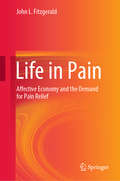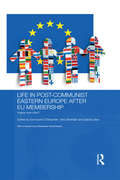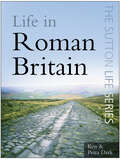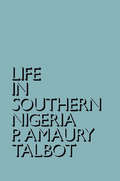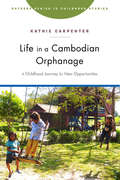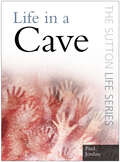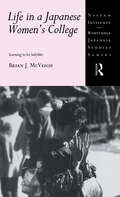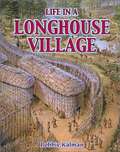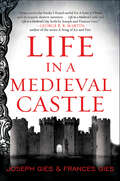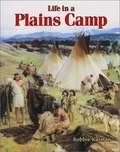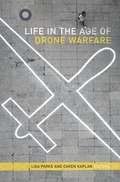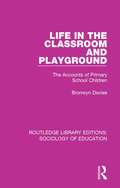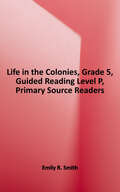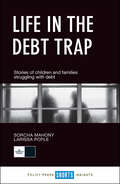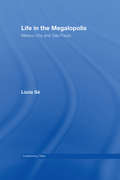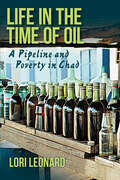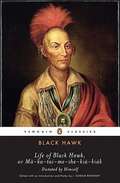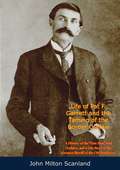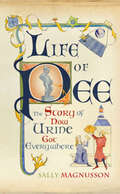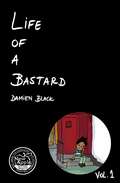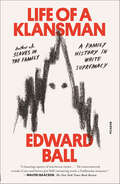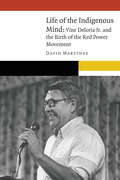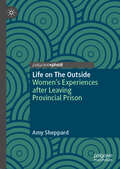- Table View
- List View
Life in Pain: Affective Economy and the Demand for Pain Relief
by John L. FitzgeraldThis book explores pain in a number of ways. At the heart of the book is an extension of Melzack’s neuromatrix theory of pain into the social, cultural, and economic fields. Specific assemblages involving varied institutions, flows of capital, encounters, and social and economic structures provide a framework for the formation of pain, its perception, experience, meaning, and cultural production. Complementing the extended neuromatrix is a second theory, focussed on the propensity of western market capitalism to seek out new areas of life to subsume to capital. Pain is one such life area that is now ripe for exploitation. Although the book has theory at its heart, it draws extensively on case studies to identify the contradictions and complexities. Case studies are drawn from accounts of drug use in varied contexts such as prescription drugs, methamphetamine use, oxycodone use in North America, and the global rise of the medicinal cannabis marketplace.
Life in Post-Communist Eastern Europe after EU Membership: Happy Ever After? (Routledge Contemporary Russia And Eastern Europe Ser.)
by Donnacha Ó Beacháin Vera Sheridan Sabina StanThis book examines how membership of the European Union has affected life in the ten former communist countries of Eastern Europe that are now members of the European Union. For each country, political, economic and social changes are described and discussed, together with people’s perceptions of the effects of EU membership. Overall, the book shows how the benefits of EU membership have differed between different countries, and how perceptions about the benefits also differ and have changed over time.
Life in Roman Britain: The Sutton Life Series
by Joan P. AlcockThe authoritative and accessible look at life in Roman Britain begins with a brief overview of the province in its historical context. The book then concentrates on the social history of the 400 years of Roman occupation with thematically arranged chapters on fucisign on administration; life in the army; religion; recreation; housing; food and drink; personal lifestyle; and art and decoration. Drawing on both the latest archaeological evidence and testimony from classical writers. the author recreates the lifestyles of those who lived in this part of a once great empire. With over 100 illustrations of sites, artefacts and reconstructions, and a comprehensive further reading section, this book will appeal to anyone interested in the Roman Period in Britain.
Life in Southern Nigeria: The Magic, Beliefs and Customs of the Ibibio Tribe
by Percy Amaury TalbotThis work describes the beliefs, customs and traditions of this tribe from the Ekat district.
Life in a Cambodian Orphanage: A Childhood Journey for New Opportunities (Rutgers Series in Childhood Studies)
by Kathie CarpenterWhat is it like to grow up in an orphanage? What do residents themselves have to say about their experiences? Are there ways that orphanages can be designed to meet children's developmental needs and to provide them with necessities they are unable to receive in their home communities? In this book, detailed observations of children's daily life in a Cambodian orphanage are combined with follow-up interviews of the same children after they have grown and left the orphanage. Their thoughtful reflections show that the quality of care children receive is more important for their well-being than the site in which they receive it. Life in a Cambodian Orphanage situates orphanages within the social and political history of Cambodia, and shows that orphanages need not always be considered bleak sites of deprivation and despair. It suggests best practices for caring for vulnerable children regardless of the setting in which they are living.
Life in a Cave
by Paul JordanWhat was it like to be a caveman? What sort of house would you live in? What sort of clothes would you wear? Paul Jordan takes us back in time to see what it was really like to live in prehistoric times, what kind of animals we would have shared the land with, and what our daily life would involve. How would you have managed in this strange and difficult world?
Life in a Japanese Women's College: Learning to be Ladylike (Nissan Institute/Routledge Japanese Studies)
by Brian J. McVeighOne third of the Japanese female workforce are 'office ladies' and their training takes place in the many women's junior colleges. Office ladies are low-wage, low-status secretaries who have little or no job security.Brian J. McVeigh draws on his experience as a teacher at one such institution to explore the cultural and social processes used to promote 'femininity' in Japanese women. His detailed and ethnographically-informed study considers how the students of these institutions are socialized to fit their future dual roles of employees and mothers, and illuminates the sociopolitical role that the colleges play in Japanese society as a whole.
Life in a Longhouse Village
by Bobbie KalmanLearn about life in a longhouse village. Topics include how a longhouse was built, clan life, gifts from the land, and the roles of men, women, children and elders.
Life in a Medieval Castle (Medieval Life)
by Frances Gies Joseph GiesThe definitive classic used as a source for Game of Thrones: “The Gieses succeed in making a remote and unfamiliar world accessible.” —Kirkus ReviewsA bestseller by two widely respected historians, Joseph and Frances Gies’s Life in a Medieval Castle remains a timeless work of popular medieval scholarship.Focusing on Chepstow, an English castle on the Welsh border that survived the turbulent Middle Ages with a relative lack of violence, the book offers an exquisite portrait of what day-to-day life was actually like during the era, and of the key role the castle played. The Gieses take us through the full cycle of a medieval year, dictated by the rhythms of the harvest. We learn what lords and serfs alike would have worn, eaten, and done for leisure—and of the outside threats the castle strove to keep at bay.“The authors allow medieval man and woman to speak for themselves through selections from past journals, songs, even account books.” —TimeIncludes photographs and maps
Life in a Plains Camp
by Bobbie KalmanThis book talks about the life of native Americans who lived in the Great Plains region -- their clothing, food, shelter and other interesting facts about their lifestyle.
Life in the Age of Drone Warfare
by Caren Kaplan Lisa ParksThis volume's contributors offer a new critical language through which to explore and assess the historical, juridical, geopolitical, and cultural dimensions of drone technology and warfare. They show how drones generate particular ways of visualizing the spaces and targets of war while acting as tools to exercise state power. Essays include discussions of the legal justifications of extrajudicial killings and how US drone strikes in the Horn of Africa impact life on the ground, as well as a personal narrative of a former drone operator. The contributors also explore drone warfare in relation to sovereignty, governance, and social difference; provide accounts of the relationships between drone technologies and modes of perception and mediation; and theorize drones’ relation to biopolitics, robotics, automation, and art. Interdisciplinary and timely, Life in the Age of Drone Warfare extends the critical study of drones while expanding the public discussion of one of our era's most ubiquitous instruments of war. Contributors. Peter Asaro, Brandon Wayne Bryant, Katherine Chandler, Jordan Crandall, Ricardo Dominguez, Derek Gregory, Inderpal Grewal, Lisa Hajjar, Caren Kaplan, Andrea Miller, Anjali Nath, Jeremy Packer, Lisa Parks, Joshua Reeves, Thomas Stubblefield, Madiha Tahir
Life in the Classroom and Playground: The Accounts of Primary School Children (Routledge Library Editions: Sociology of Education #17)
by Bronwyn DaviesThis study, first published in 1982, approaches children from an ethogenic viewpoint. It records their own accounts of their social world and sees them as members of a distinct culture with its own perspective, code of behaviour and strategies for making sense of their lives. The author suggests that teachers who can take the pupil’s perspective into account will work together more successfully with these pupils in the process of communicating their adult knowledge to the children. This title will be of interest to students of sociology and education.
Life in the Colonies (Primary Source Readers)
by Emily R. SmithYoung readers will be fascinated to learn what life was like for the colonists in early America. The detailed images and easy-to-read text explore such topics as Puritans, the Mayflower Compact, House of Burgesses, the Navigation Acts, and slavery. <p><p>Along with brief biographies on colonists and Indians like John Smith, William Penn, Pocahontas, and John Rolfe, this engaging reader explains the means of survival and living through farming, colonial crops, and plantations. A table of contents and glossary are provided to enhance readers' understanding of the content and vocabulary.
Life in the Debt Trap: Stories of Children and Families Struggling with Debt
by Sorcha Mahony Larissa PopleWhat is life like for families who are stuck in problem debt? Why do they fall into a spiral of debt in the first place, and why is it so hard to escape? The first hand stories in this book offer a unique understanding of life for families and children fighting a daily battle against poverty and debt. They give voice to some of the most underrepresented people in society, who are too often portrayed cruelly in the media and elsewhere. Drawing on research data collected through The Children’s Society’s Debt Trap campaign, this book explores the causes, implications and impacts of problem debt, challenges pejorative public attitudes and encourages more compassionate policy making to help families escape poverty and debt.
Life in the Himalaya: An Ecosystem at Risk
by Maharaj K. PanditThe collision of the Indian and Eurasian plates 50 million years ago created the Himalaya, along with massive glaciers, intensified monsoon, turbulent rivers, and an efflorescence of ecosystems. Today, the Himalaya is at risk of catastrophic loss of life. Maharaj Pandit outlines the mountain’s past in order to map a way toward a sustainable future.
Life in the Megalopolis: Mexico City and Sao Paulo (Questioning Cities)
by Lucia SaThe modern metropolis has been called 'the symbol of our times', and life in it epitomizes, for many, modernity itself. But what to make of inherited ideas of modernity when faced with life in Mexico City and São Paulo, two of the largest metropolises in the world? Is their fractured reality, their brutal social contrasts, and the ever-escalating violence faced by their citizens just an intensification of what Engels described in the first in-depth analysis of an industrial metropolis, nineteenth century Manchester? Or have post-industrial and neo-globalized economies given rise to new forms of urban existence in the so-called developing world? Life in the Megalopolis: Mexico City and São Paulo investigates how such questions are explored in cultural productions from these two Latin American megalopolises, the focus being on literature, film popular music, and visual arts. This book combines close readings of works with a constant reference to theoretical, anthropological and social studies of these two cities, and builds on received definitions of the concept megalopolis Life in the Megalopolis is the first book to combine urban-studies theories (particularly Lefebvre, Harvey, and de Certeau) with Benjaminian cultural analyses, and theoretical discussions with close-readings of recent cultural works in various media. It is also the first book to compare Mexico City and São Paulo.
Life in the Time of Oil: A Pipeline And Poverty In Chad
by Lori LeonardLife in the Time of Oil examines the Chad-Cameroon Petroleum Development and Pipeline Project--a partnership between global oil companies, the World Bank, and the Chadian government that was an ambitious scheme to reduce poverty in one of the poorest countries on the African continent. Key to the project was the development of a marginal set of oilfields that had only recently attracted the interest of global oil companies who were pressed to expand operations in the context of declining reserves. Drawing on more than a decade of work in Chad, Lori Leonard shows how environmental standards, grievance mechanisms, community consultation sessions, and other model policies smoothed the way for oil production, but ultimately contributed to the unraveling of the project. Leonard offers a nuanced account of the effects of the project on everyday life and the local ecology of the oilfield region as she explores the resulting tangle of ethics, expectations, and effects of oil as development.
Life of Black Hawk, or Ma-ka-tai-me-she-kia-kiak
by Black HawkA controversial figure in his day, Black Hawk was the leader of the Sauk American Indian tribe in the early 1800s. The son of the tribe s medicine man, Black Hawk s exploits as a warrior aided his rise to the status of tribal war leader. Here, Black Hawk chronicles his life as well as the story of his tribe, who were forced from their lands in Illinois during a series of skirmishes with American settlers in what came to be known as the Black Hawk War.
Life of Pat F. Garrett and the Taming of the Border Outlaw: A History of the “Gun Men” And Outlaws, and a Life-Story of the Greatest Sheriff of the Old Southwest
by John Milton ScanlandPatrick Floyd Jarvis Garrett (1850-1908) was an American Old West lawman, bartender and customs agent who became renowned for killing Billy the Kid. He was the sheriff of Lincoln County, New Mexico as well as Doña Ana County, New Mexico.Life of Pat F. Garrett and the Taming of the Boarder Outlaw tells the story of the sheriff who pursued and killed Billy the Kid. Authored by John Milton Scanland, a newspaperman who knew both Pat F. Garrett and New Mexico well, the book was written shortly after Pat F. Garrett’s own slaying in 1908.A thrilling read, no collection of Western Outlaw material is complete without it.
Life of Pee: The Story of How Urine Got Everywhere
by Sally MagnussonA frank and humorous encyclopedic history of the forgotten life of urine and its many uses in society.Alchemists sought gold in it. David Bowie refrigerated it to ward off evil. In the trenches of Ypres soldiers used it as a gas mask, whereas modern-day terrorists add it to home-made explosives. All the Fullers, Tuckers and Walkers in the phonebook owe their names to it, and in 1969 four bags for storing it were left on the surface of the moon.Bought and sold, traded and transported, even carried to work in jugs, urine has made bread rise, beer foam and given us gunpowder, stained glass, Robin Hood’s tights, and Vermeer’s Girl With A Pearl Earring.And we do produce an awful lot of it. Humans alone make almost enough to replace the entire contents of Loch Lomond every year. Add the incalculable volume contributed by the rest of the animal kingdom and it might soon displace a small ocean. No wonder it gets everywhere.In Life of Pee Sally Magnusson unveils the secret history of civilization’s most unsavory and unsung hero, and discovers how our urine footprint is just as indelible as our carbon one.
Life of a Bastard
by Damien BlackNato nella Harlem Spagnola nel 1972 da madre portoricana e padre afroamericano, Javier Soto non è altro che un difetto sul volto della società americana. Dopo essere scampato ad un incendio probabilmente causato da sua madre mentre suo padre è in prigione, Javier e le sue sorelle vengono rimossi dalla loro casa e inseriti nel sistema dell’affidamento. La storia vera della vita di Javier Soto, il suo viaggio di famiglia in famiglia tra brutalità e violenze, viene raccontata in questo libro in toni crudi ma toccanti. La sua storia, cominciata nei servizi sociali cattolici, illustra la sua evoluzione da bambino innocente ad adolescente arrabbiato, passando attraverso abusi, malnutrizione, abbandono, solitudine. Come migliaia di bambini americani gettati nel sistema dell’affidamento, Javier e le sue sorelle vengono ripetutamente scaricati in famiglie adottive, ciascuna delle quali ha lasciato cicatrici indelebili su di loro. Dopo essere stato brutalmente separato dalle sue sorelle, Javier deve continuare la sua battaglia per la sopravvivenza da solo. Un racconto indimenticabile sull’angoscia, sull’autodistruzione e su quel desiderio di essere amati che Javier non riuscirà mai a soddisfare. Con delle basi così esigue su cui fondare le sue speranze, quanta strada potrà fare Javier?
Life of a Klansman: A Family History in White Supremacy
by Edward Ball"A haunting tapestry of interwoven stories that inform us not just about our past but about the resentment-bred demons that are all too present in our society today . . . The interconnected strands of race and history give Ball’s entrancing stories a Faulknerian resonance." —Walter Isaacson, The New York Times Book ReviewA 2020 NPR staff pick | One of The New York Times' thirteen books to watch for in August | One of The Washington Post's ten books to read in August | A Literary Hub best book of the summer| One of Kirkus Reviews' sixteen best books to read in AugustThe life and times of a militant white supremacist, written by one of his offspring, National Book Award–winner Edward BallLife of a Klansman tells the story of a warrior in the Ku Klux Klan, a carpenter in Louisiana who took up the cause of fanatical racism during the years after the Civil War. Edward Ball, a descendant of the Klansman, paints a portrait of his family’s anti-black militant that is part history, part memoir rich in personal detail.Sifting through family lore about “our Klansman” as well as public and private records, Ball reconstructs the story of his great-great grandfather, Constant Lecorgne. A white French Creole, father of five, and working class ship carpenter, Lecorgne had a career in white terror of notable and bloody completeness: massacres, night riding, masked marches, street rampages—all part of a tireless effort that he and other Klansmen made to restore white power when it was threatened by the emancipation of four million enslaved African Americans. To offer a non-white view of the Ku-klux, Ball seeks out descendants of African Americans who were once victimized by “our Klansman” and his comrades, and shares their stories.For whites, to have a Klansman in the family tree is no rare thing: Demographic estimates suggest that fifty percent of whites in the United States have at least one ancestor who belonged to the Ku Klux Klan at some point in its history. That is, one-half of white Americans could write a Klan family memoir, if they wished.In an era when racist ideology and violence are again loose in the public square, Life of a Klansman offers a personal origin story of white supremacy. Ball’s family memoir traces the vines that have grown from militant roots in the Old South into the bitter fruit of the present, when whiteness is again a cause that can veer into hate and domestic terror.
Life of a Slave on a Southern Plantation
by Stephen CurrieThis book describes the lives of slaves on southern plantations, including information on family life, food and housing, work, play, punishment, and escape. Dozens of quotations from plantation owners and visitors, abolitionists, and especially the slaves themselves help bring the period to life for readers.
Life of the Indigenous Mind: Vine Deloria Jr. and the Birth of the Red Power Movement (New Visions in Native American and Indigenous Studies)
by David MartínezIn Life of the Indigenous Mind David Martínez examines the early activism, life, and writings of Vine Deloria Jr. (1933–2005), the most influential indigenous activist and writer of the twentieth century and one of the intellectual architects of the Red Power movement. An experienced activist, administrator, and political analyst, Deloria was motivated to activism and writing by his work as executive director of the National Congress of American Indians, and he came to view discourse on tribal self-determination as the most important objective for making a viable future for tribes. In this work of both intellectual and activist history, Martínez assesses the early life and legacy of Deloria’s “Red Power Tetralogy,” his most powerful and polemical works: Custer Died for Your Sins (1969), We Talk, You Listen (1970), God Is Red (1973), and Behind the Trail of Broken Treaties (1974). Deloria’s gift for combining sharp political analysis with a cutting sense of humor rattled his adversaries as much as it delighted his growing readership.Life of the Indigenous Mind reveals how Deloria’s writings addressed Indians and non-Indians alike. It was in the spirit of protest that Deloria famously and infamously confronted the tenets of Christianity, the policies of the Bureau of Indian Affairs, and the theories of anthropology. The concept of tribal self-determination that he initiated both overturned the presumptions of the dominant society, including various “Indian experts,” and asserted that tribes were entitled to the rights of independent sovereign nations in their relationship with the United States, be it legally, politically, culturally, historically, or religiously.
Life on The Outside: Women’s Experiences after Leaving Provincial Prison
by Amy SheppardThis book seeks to understand how women's experiences both within and outside prisons shape their ability to engage in crime-free living after the experience of prison. It uses women's stories to examine their cognitive shifts toward desistance as well as the structural services that may help with the desistance process. It also examines the impacts of addiction and stigma on the desistance processes and develops the theories of desistance. Written by a practitioner, this book includes the voices of service providers who are rarely heard from to provide unique insight into how criminalized women's desistance processes can be supported. It offers intersectional, feminist perspectives and anti-carceral/ abolitionist perspectives.
